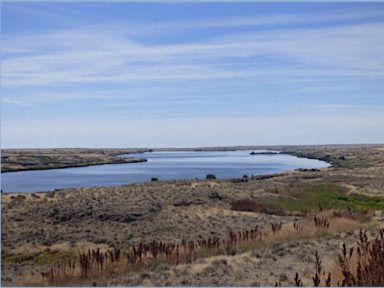Sample photos of some of the flood formations
These are just a few of the flood formations that you will encounter on your tour
Purchase the Ice Age Flood Tour
You can purchase a copy of The Ice Age Flood Tour to begin your unforgettable journey at the Lulu Publishing Bookstore for $19.80. The book is also available as an eBook for $10.95.
You can view my other books available from the bookstore by clicking on the "Go to author's page" link at the bottom of the page.

Introduction to the Ice Age Flood
Geologic History and the Flood Today
Before the flood, during pre-historic times there was a massive shield volcano located in the southeastern corner of Washington and northeastern corner of Oregon. It spewed layers upon layers of very fluid lava covering eastern Washington, western Idaho, and flowed down the Columbia River Valley all the way to the Pacific Ocean. There were up to 300 flows of lava accumulating up to over two miles thick in places. The total amount of accumulated basalt was 175,000 cubic kilometers. The weight of the accumulated basalt is said to have been so heavy that it caused the earth’s crust in Eastern Washington to sink, creating what is known as the Columbia Basin.
During the last ice age, the massive glaciers, several miles thick moved down from Canada. In eastern Washington, the glaciers stopped about where the Columbia River turns to flow westward near Spokane. The run-off of silt from the glaciers accumulated in eastern Washington and blew into the huge wind-blown loess hills, known as the Palouse Hills. Those hills are noted for the rich soil on which dry-land wheat is now grown.
As the glaciers advanced a huge ice dam developed in northern Idaho at what is now Lake Pend Oreille. The dam blocked the Clark Fork River flowing out of Montana, creating what has been called Glacial Lake Missoula. The lake at the dam was about 2000 feet deep and held approximately 500 cubic miles of water, making it larger than Lake Erie and Lake Ontario combined or one-half the size of Lake Michigan.
Eventually that dam broke, and all the water came crashing out. The silt-laden, boulder filled water rushed down the Purcell Trench in Idaho southeast of Rathdrum, Idaho and across eastern Washington carving the basalt, cutting through the Palouse Hills, rushing down the Grand Coulee, creating the simply unbelievable channeled scablands, coulees, hanging waterfalls, and down the Columbia River widening and deepening the Columbia River Gorge, even backing up into the Willamette Valley of Oregon. There was a second ice dam at the site of the present-day Grand Coulee Dam creating Glacial Lake Columbia.
Imagine a torrent of water 1000 (+/-) feet deep roaring across the landscape at 60 to 70 miles per hour.
During my recent positions as an Interpretation Park Ranger at Lake Roosevelt National Recreation Area, I became extremely interested in the Lake Missoula Ice Age Flood(s) that shaped the landscape of Eastern Washington and the Columbia River Gorge between Oregon and Washington. As a part of my position, we were encouraged to conduct research into the flood in order that we might explain or interpret the unique geologic features that are so evident in the park and the surrounding area.
Lake Roosevelt is the lake behind Grand Coulee Dam. The lake now fills the Grand Coulee that was carved out by the massive Glacial Lake Missoula Flood(s)
I was impressed by the fact that there are relatively few guides to the features of the flood in Washington. Also, what I was seeing seemed to contradict the view of many geologists that there were multiple floods, up to as many as 100. This interpretation also contradicted my view and that of many geologists commonly referred to as creationists. Their view of just one or at most a few floods is also more in keeping with my view as a Christian and belief that God created the heavens and the earth perhaps a few thousand years ago rather than having evolved over millions or billions of years.
© Copyright. All rights reserved.
We need your consent to load the translations
We use a third-party service to translate the website content that may collect data about your activity. Please review the details in the privacy policy and accept the service to view the translations.















